Highlands’ history dates back to the Victorian era and throughout all of these years, it has always had a holiday connection to it – rather appropriate for its current use as holiday apartments!
At the time, the Isle of Wight was rather in vogue with high society with many wishing to follow the example set by Queen Victoria after she made the island her holiday home with her purchase of Osborne House. Within the vicinity of Highlands in this period, other residents included Lord Alverstone in Alverstone Manor, attorney general and lord chief justice, Colonel Henry George Gore-Browne VC of Monteagle, colonel, magistrate and deputy governor of the island, Baron Hermann von Eckardstein at Sans Souci, first secretary at the German embassy, Michael Spartali of Rylstone Manor, Greek consul-general, as well as a plethora of retired army captains and colonels.
The land that Highlands sits on was leased from the Popham White estate and then Lord of the Manor, Francis White Popham, in 1875. During the later years of the Victorian era, Francis had started to grant leases on some of the estate’s land for the development of villas, a number of which are still around now.
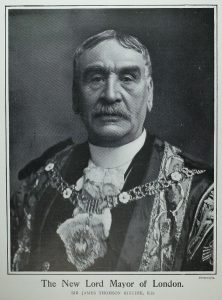
The original owner of Highlands was Sir James Thomson Ritchie JP Bt, who purchased the lease and had the house constructed by local builder Francis Cooper. It was eventually finished in 1885. Ritchie was a well known Scottish businessman and brother of Charles Ritchie, a politician who served as home secretary and chancellor of the exchequer. He lived in Queensborough Terrace just off Kensington Gardens and Hyde Park in London. His business, William Ritchie And Son, was an East India merchant and jute spinner based in Stratford. He also printed the Reliable Series of postcards, depicting scenes from across the country. Over his life, he became a magistrate and also undertook a series of public roles in the City of London, starting as an alderman for Tower ward from 1891, then sheriff of London in 1896 to 1897 and finally lord mayor of London from 1903 to 1904.
He was president of the London Jute Association and chairman of Palmer and Co candles. He was also involved with the General Nursing Institute, a boarding house and agency for nurses, as well as the unsuccessful Medina Subway Company, which had intended to build a tunnel under the River Medina. He was knighted in 1897 in connection with his work on the diamond jubilee of Queen Victoria and then awarded the baronetcy of Highlands in December 1903 at the end of his term as lord mayor. He was also awarded the freedom of the city of Dundee, his home town, in 1904. He and his wife, Lady Lydia (nee Lemon), used Highlands as their holiday home. On his passing, his contribution to the island was celebrated, noted that whilst only a frequent visitor, he offered his help and assistance to the island frequently. A lasting example of the Ritchie family are the lime trees in Priory Road and the surrounding roads, which he had planted in around 1887, and the 130 odd year old sweet chestnut tree in the garden. Lady Lydia died in December 1894 and Sir James died on 18th September 1912.
On Sir James’ passing, the house was passed to his son, Sir James William Ritchie, chairman of Milners safes, a role his father and uncle had also performed. He was due to inherit the baronetcy but it expired unexpectedly on his father’s death. He was granted his own baronet in 1918 to rectify the issue. He continued to live in the property until 1919. During the Ritchie years, the property was rented out whilst the family weren’t in occupancy and tenants included Albert and Florence Landsberg (1901), Fanny Louisa Walker (daughter of Charles Hay Walker from The Cliff) (1911) and Anna and Hetty Crowdy (Winter 1911).
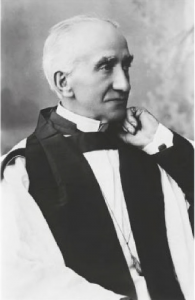
In late 1919, Reverend Doctor William Page Roberts DD moved into Highlands. He retired to Shanklin, his “place in the sun”, from his role as Dean of Salisbury, which commenced in 1907, with his second wife Margaret Grace (nee Pitt-Rivers), daughter of peer and politician George Pitt-Rivers, 4th Baron Rivers. He started his preaching in Stockport before moving to Eye and then St Peter’s in Vere Street, London, which he was nominated to by Prime Minister Benjamin Disraeli and Queen Victoria. Whilst at St Peter’s, he was also made residentiary canon at Canterbury Cathedral and additionally preached regularly at Westminster Abbey. He was chaplain to the Lord Mayor of London between 1901 and 1902, Sir Joseph Dimsdale MP. Given this overlapped with Sir James Thomson Ritchie’s time as alderman and they were documented as both attending a number of the same events for their roles, there may be a connection between them that resulted in the move to Highlands. In his retirement, he continued to occasionally take Sunday service in local churches on the island, still preaching at St Blasius just 3 weeks before his death. Margaret died on 21st April 1926 and William died on 17th August 1928. Two stained glass window dedicated to the couple were gifted by their daughters to Salisbury Cathedral in 1933, which you can see here, and a tablet in memory of William was installed in St Peter’s in 1931.
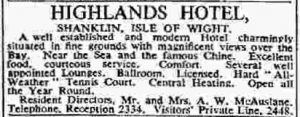
After William’s death, the property was sold to Alexander William McAuslane and his wife Dorothy May Elizabeth (nee Dowdall) and it was converted to become Highlands Hotel, opening in 1930. Alexander worked in the city until 1934, splitting his time between there and Shanklin. Over the years, the hotel was extended with two new wings added to the east and west of the building in the 1930s. During the Second World War, it is believe that the hotel was commandeered as a Home of Rest Hospital from around 1941 to 1944, most likely due to the close proximity to Luccombe’s cottage hospital across the road and its perfect set up from being a hotel. Alexander died on 21st September 1963 and Dorothy died on 23rd January 1968, passing on the hotel to her daughter, a locally well known equestrian Jean Margaret (died 7th August 2013) and her husband Colin W Johnson (died 21st July 2017). They continued to run the hotel but it suffered a fire in 1969, the building’s second after one in 1903.
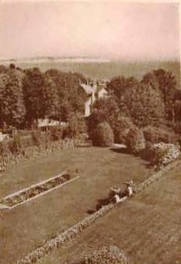
In April 1971, the property was put up for auction. The next owner of Highlands was Upper Chine School, which owned a number of buildings in Priory Road and the surrounding area as part of the school and boarding houses. The deputy headmistress, Margaret Passmore, heard rumours that a potential bidder in the auction was a looking to convert the building to a nightclub with a 2am license. Concerned with the impact it would have on the boarding houses, the school snapped up the property before the auction for £40,000, above the market value of £30,000 to £32,000. It was used as accommodation for visitors and older students and was noted for its sweeping staircase and ballroom, as well as being a bit cold! It was used for sewing and music lessons and was in use until the 1980s. Whilst removing ivy from our sweet chestnut tree, we found some Belgian coins dating back to the school’s era hided in the ivy – a playtime bit of fun! During the 1970s, some of the land was sold for development with Luccombe Court to the west, which was approved in June 1975, and Tay Lodge to the north constructed.
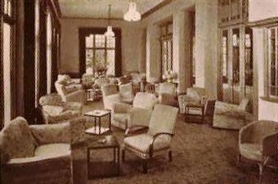
The building stopped being used by the school in its final years before it merged with Ryde School in 1994 and was believed to have been sold in around 1989. A fire broke out in May 1994, which destroyed much of the original Victorian building. It was demolished between approximately September 1994 and June 1996. In its place, Bay House and Highlands were constructed between 2003 and 2006 with the new Highlands taking some cues from the original with its large proportions and bay window. After construction, it was never finished and passed between several developers and left derelict until 2014, when we purchased the building and converted it into a number of apartments, which are now used as holiday apartments, echoing the original’s time as a holiday home and hotel.
The history of Highlands is always a work in progress, so if you have any further information, do get in touch.
History compiled with own research as well as contributions from Shanklin and District History Society and Isle of Wight Council.
